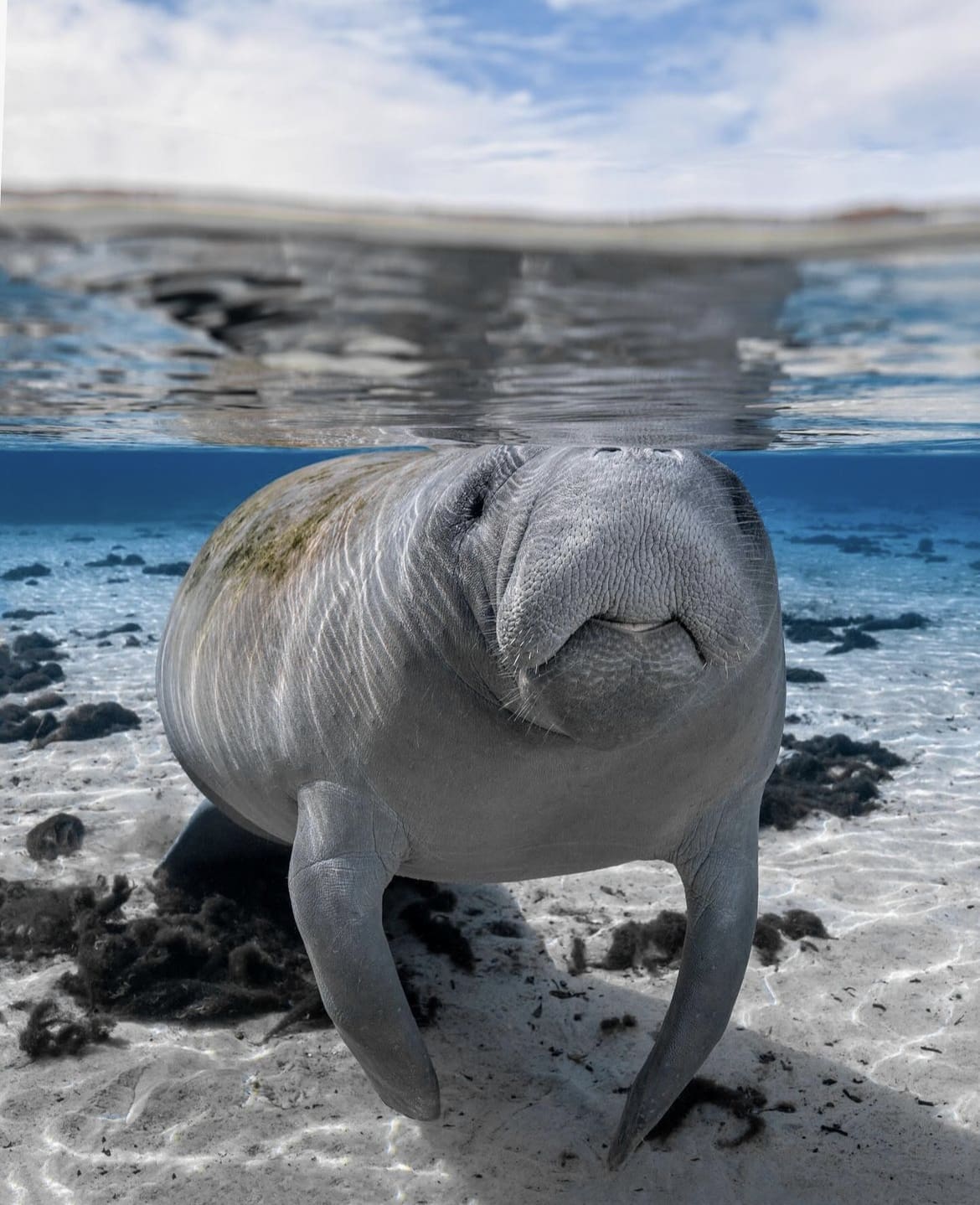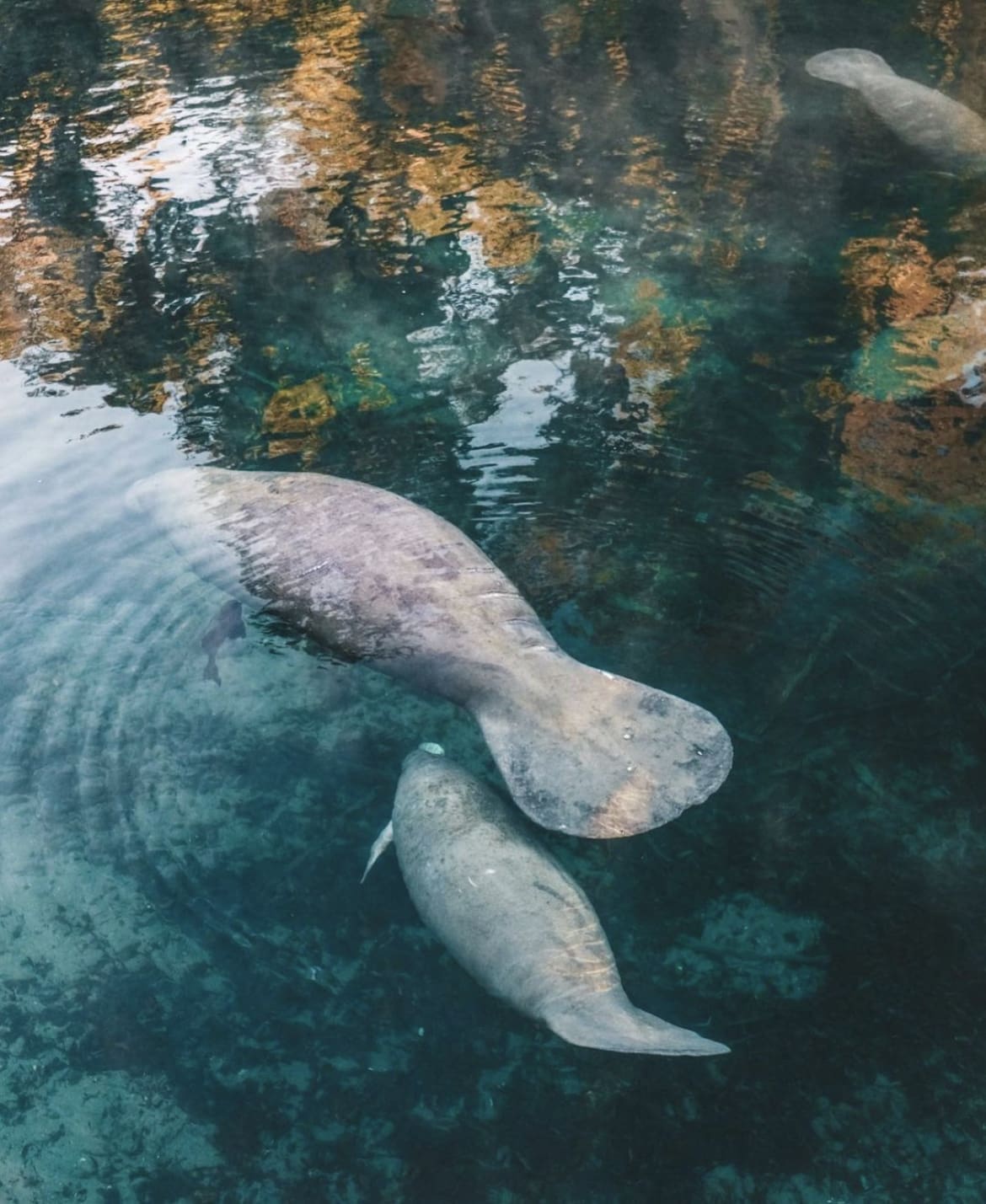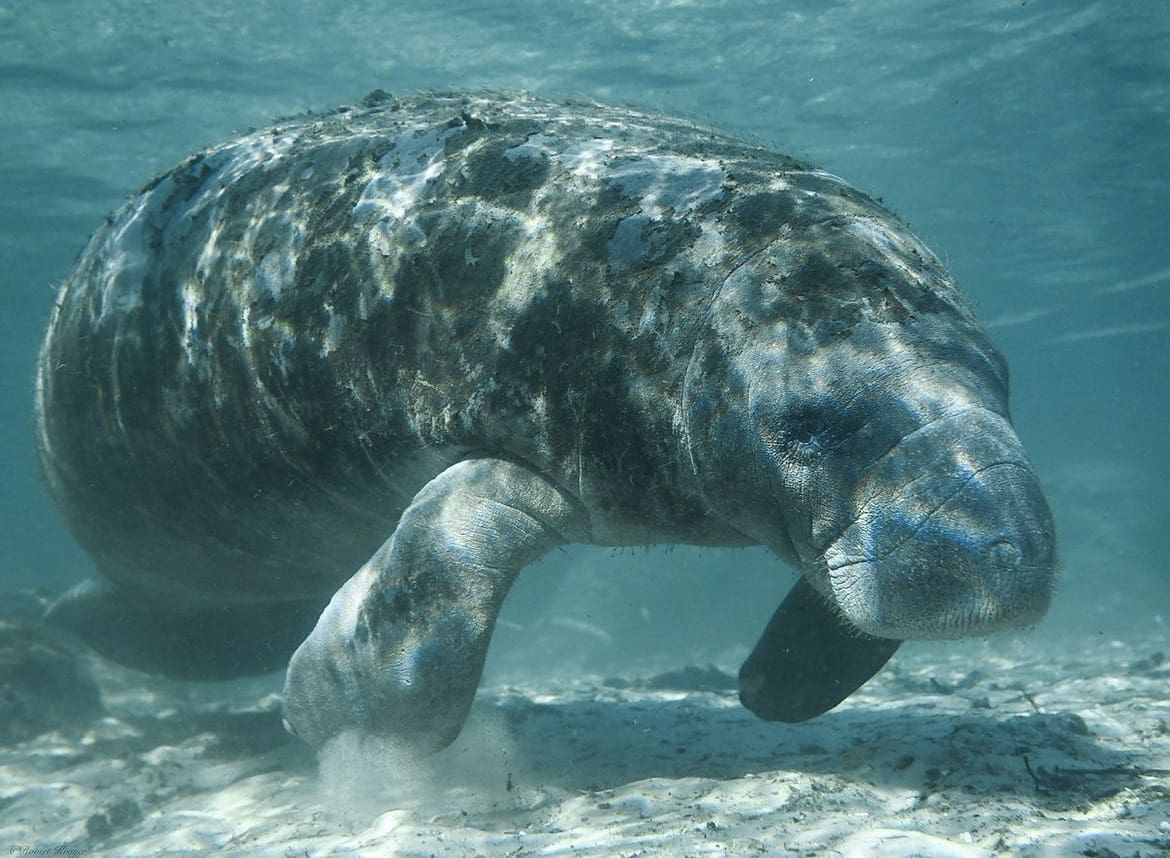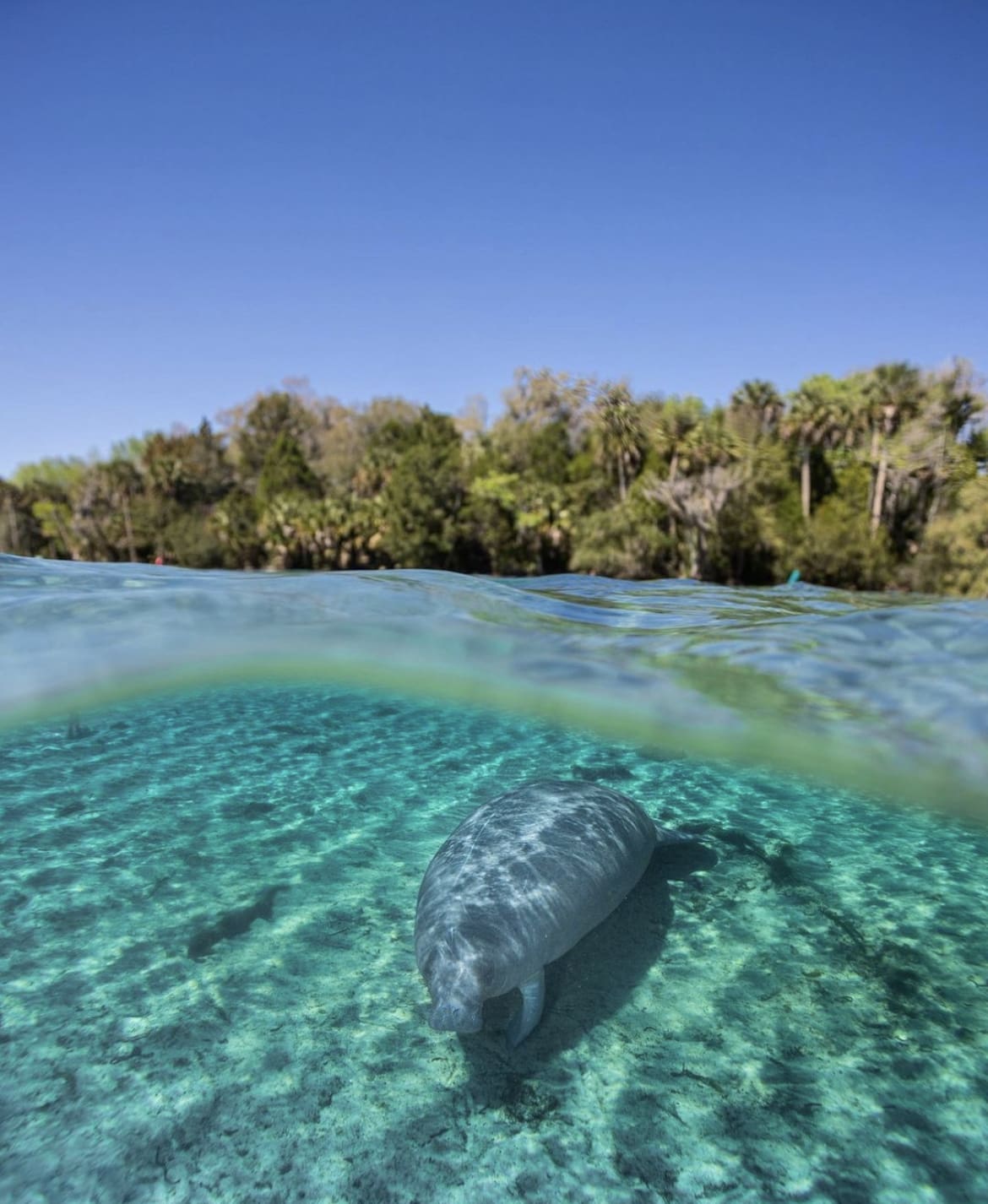These gentle giants, often dubbed as the “sea cows” of the marine world, are about to become your new favorite aquatic animal. So, buckle up as we dive deep into the world of manatees, uncovering everything from their chill lifestyle to their surprising quirks.
Trust me, by the end of this, you’ll be as obsessed with manatees as the internet is with cat videos.
What is the Manatee
Manatees are like the Zen masters of the sea. Belonging to the order Sirenia, they’re the laid-back, herbivorous mammals that grace warm coastal waters, rivers, and springs. Imagine a creature so chill, it spends its days munching on sea grass, taking leisurely swims, and basically embodying the vibe of a permanent beach vacation. That’s a manatee for you.
They’re known for their gentle nature, slow metabolism, and the fact that they have no natural enemies (besides humans, but more on that later). Calling them “sea cows” might give you the impression they’re not the sharpest tools in the shed, but these creatures are fascinatingly smart and have complex social behaviors. They’re an integral part of marine ecosystems, acting as vital links in aquatic plant life cycles and waterway health.
Manatee vs Dugong
Now, you might be thinking, “Aren’t manatees and dugongs the same thing?” Well, not quite. While they’re close relatives and share the same family album under Sirenia, there are some key differences that set them apart. First off, their tails – manatees have a paddle-shaped tail that’s like the oar of a rowboat, while dugongs sport a dolphin-like fluked tail. It’s like comparing a spoon to a fork; both useful, but for different dining experiences.
Then there’s their habitat. Manatees are more of the globe-trotters, found in the warm waters of the Atlantic, particularly along the North American east coast down to Brazil, and across to the west coast of Africa. Dugongs, on the other hand, are the homebodies, sticking mainly to the Indo-Pacific region.
When it comes to lifestyle, both enjoy a good sea salad, but dugongs are a bit more selective, almost exclusively dining on seagrasses. Manatees? They’re not so picky, happy to chow down on a variety of water plants.

What do Manatees Look Like
Picture this: a creature that’s part elephant, part dolphin, and part vacuum cleaner (for its impeccable ability to suck up sea grass). That’s your manatee. They’ve got this round, plump body that’s all about maximizing chill. Their faces are squishy, with whiskered snouts that they use to forage for food along the sea floor. And their eyes? Small but expressive, giving off a vibe of serene wisdom.
Manatees’ bodies taper off into their distinctive paddle-like tail, which they use to gracefully propel through the water. Their flippers look like a cross between a seal’s and your favorite pair of oven mitts, complete with nails that remind us of their terrestrial ancestors. Yeah, believe it or not, manatees share a distant relative with elephants. Their skin is a patchwork of wrinkles and whiskers, often hosting a community of algae which gives them a greenish hue, adding to their camouflage among the sea grasses they love so much.
How Big are Manatees
When it comes to size, manatees are the gentle giants of the sea, with newborns already tipping the scales more than your average Thanksgiving turkey. These aquatic mammals can grow to be about 10 to 13 feet long, weighing in at a hefty 800 to 1,200 pounds.
That’s like combining the weight of a small car or a grand piano into a single, blubbery, adorable marine creature. Some manatees have been known to reach up to 3,500 pounds in the wild, making them the heavyweight champions of the sea grass buffet. Their size is all about buoyancy and insulation, helping them maintain a slow and steady metabolism.
So, next time you’re feeling bad about skipping the gym, just remember: manatees are living their best life at their own pace, and they’re doing just fine.
Manatee Skin
If manatees had a skincare routine, it would be all-natural, featuring a healthy dose of algae and marine growth. Manatee skin is thick and wrinkled, resembling a well-worn leather couch that’s seen its fair share of Netflix binges. This isn’t just for aesthetics; their skin is crucial for thermoregulation, helping them keep warm in cooler waters.
The rough texture also provides a prime real estate for algae, which can give manatees a greenish tinge, turning them into the hipsters of the sea with their natural, earthy look. Despite their tough exterior, manatees are prone to scars and marks from encounters with boats and other hazards, serving as a reminder of the challenges they face in their aquatic habitats.

Manatee Tails
The manatee tail is where the magic happens. Unlike any other creature, their paddle-shaped tail is a marvel of marine engineering, allowing them to navigate the slow-moving rivers and coastal waters they call home.
Think of it as the manatee’s version of an all-in-one propeller and rudder system, enabling them to move forward with gentle strokes or steer themselves by flexing it side to side. Their tails are not just functional; they’re a key identifier for researchers, as the patterns of scars and markings are unique to each manatee, much like a fingerprint.
Watching a manatee glide through the water with its tail is witnessing a blend of power and grace, a testament to the adaptability and resilience of these amazing creatures.
Manatee Coloration
If manatees were part of the fashion world, they’d be rocking the minimalist, earth-tone look all year round. Their coloration ranges from a gray to a brownish-gray, giving them that sleek, understated vibe that’s totally in right now. This isn’t just about looking good for the ‘gram; their color helps them blend into the murky waters of their coastal and riverine habitats, providing some camouflage from predators.
But let’s be real, their main threat is humans, not fashion critics. And while they might not be sporting the latest in underwater haute couture, their simple coloration is perfectly suited to their laid-back lifestyle and habitat needs.
What do Manatees Eat?
Speaking of lifestyle, let’s talk about what these gentle giants like to munch on. Manatees are the vegans of the sea, with a strict plant-based diet that would make any health enthusiast proud. They spend up to seven hours a day grazing on sea grasses and algae, consuming about 4% to 9% of their body weight daily.
That’s like if you ate 8 pounds of salad every single day, minus the Instagram posts about it. Their feeding habits play a crucial role in maintaining healthy aquatic ecosystems, as they help control algae blooms and ensure sea grass beds are in tip-top shape. So, next time you’re enjoying a kale smoothie, give a nod to the manatees for keeping it green.
Manatee Social Structure
Now, onto their social lives. Manatees might seem like they’re all about that solitary life, but they’re actually quite social creatures. They don’t form tight-knit groups like dolphins or killer whales, but they’re known to have casual meet-ups where they chill, share the best grazing spots, and communicate with a range of sounds, from chirps to whistles and squeaks.
These gatherings can be quite the social event, with manatees touching and nuzzling each other, showing that even the most laid-back creatures need some TLC. Their social structure is loose and flexible, allowing them to come and go as they please, which is pretty much the dream social scenario for anyone who hates making plans.
How do Manatees Reproduce?
Manatees might take the cake for being laid-back, but when it comes to reproduction, they’re surprisingly social butterflies. They engage in what’s known as a “mating herd,” which is essentially a chill pool party where one female is followed by a group of males vying for her attention.
This isn’t some quick match on a dating app; these gatherings can last for weeks, with the female leading her suitors on a merry chase through the waters. Eventually, she’ll choose a mate, but the social dynamics of these herds play a crucial role in their mating rituals.
Manatee pregnancies then take about 12 to 14 months, culminating in the birth of a single calf, though twins are a rare but adorable exception. Manatee moms are all about that single parenting life, nurturing their calves for up to two years, teaching them the ropes of manatee life.
How Long do Manatees Live?
Now, if you’re wondering how long these aquatic munchers grace our waters, manatees can live pretty long lives, with many reaching up to 40 years or more in the wild. Their lifespan is a testament to their chill lifestyle, but it’s also heavily influenced by their environment and, unfortunately, human activity.
While they can live to be the sea equivalent of wise old sages, their lives are often cut short by boat strikes, entanglement in fishing gear, and habitat loss. Protecting these gentle giants and their habitats is crucial for ensuring they live out their full lifespans, basking in the warm waters and contributing to healthy aquatic ecosystems.

Are Manatees Aggressive?
For creatures that spend their days grazing on sea grass and floating around, you might wonder if manatees ever get their flippers dirty.
The answer is a resounding no. Manatees are the epitome of peaceful marine life; they’re not aggressive and have no natural predators, except for the most dangerous of all—humans. Their calm demeanor extends to their interactions with each other and with humans.
While they’re curious and may approach divers or swimmers, they do so with gentle curiosity, not aggression. It’s important for us to match their peaceful approach, observing them from a respectful distance and not disturbing their natural behaviors.
Are Manatees Territorial?
When it comes to space, manatees are pretty much the opposite of your typical city dweller fighting for a spot on the subway. These aquatic nomads don’t set up permanent homes or defend specific territories.
Instead, they’re all about that nomadic life, roaming vast areas in search of food, warmth, and breeding grounds. Their laid-back nature extends to their social interactions, as they share their spaces and food sources without a fuss. Imagine a world where everyone just gets along, floating by without a worry – that’s the manatee way.
Where do Manatees Live?
Manatees are the globe-trotters of the marine world, albeit at a leisurely pace. These creatures primarily hang out in shallow, coastal areas, rivers, and freshwater springs, with a preference for the warm waters of the Florida coast during winter. Their range extends from the southeastern United States down to the Caribbean and along the coastlines of the Amazon Basin.
They’re partial to places where the water temperature doesn’t dip below 20°C (68°F), because, let’s face it, nobody likes being cold. Their habitats are crucial not just for their survival but also for the ecosystems they support, as their grazing helps maintain healthy aquatic environments.

How Many Manatees are There in the Wild?
Counting manatees is a bit like trying to count jellybeans in a jar while the jar is in murky water – it’s challenging, to say the least. However, efforts to monitor their populations have provided some insights. In the United States, particularly in Florida, aerial surveys and tagging programs have estimated thousands of individuals, though exact numbers fluctuate due to various factors, including migration and the accuracy of counting methods.
Globally, manatees are considered vulnerable, with specific populations facing different levels of threat. Their numbers are a moving target, but what’s clear is the need for ongoing conservation efforts to ensure these serene sea cows continue to grace our waters.
Are Manatees Endangered?
In the grand tapestry of wildlife conservation, manatees hold a peculiar spot. Officially, they’re listed as “vulnerable” on the IUCN Red List, but don’t let that fool you into thinking they’re out of the woods. In regions Florida, manatees were downgraded from “endangered” to “threatened” thanks to significant conservation efforts that helped their numbers rebound.
However, the battle is far from over. Habitat loss, water pollution, and boat strikes remain pressing threats that could easily tip the scales back. It’s a reminder that conservation is an ongoing journey, not just a destination.
Threats to Manatees in the Wild
Manatees might not have natural predators, but they’re facing an onslaught of human-made challenges that are just as deadly. Boat strikes top the list, with their slow-moving, surface-skimming nature making them vulnerable to fast-moving watercraft.
Then there’s the issue of habitat degradation, where waterfront development and pollution choke the life out of the aquatic gardens they call home. Climate change also throws a curveball, threatening the warm-water refuges vital for their survival.
In essence, manatees are caught in a storm of environmental and human challenges, navigating a world that’s changing faster than they can swim.

Where to See Manatees In the Wild
Now, for the lighter side of things – where to witness these majestic sea cows in their natural, or at least semi-natural, habitats. Florida is the hotspot, with Crystal River and Blue Spring State Park leading the pack for manatee encounters. These sanctuaries offer a unique opportunity to observe manatees up close, especially during the winter months when they flock to the warm springs.
For a more tropical adventure, the coastal waters of Belize and the Amazon River are prime spots for spotting these gentle giants. Whether you’re snorkeling in crystal-clear springs or cruising down the Amazon, seeing manatees in the wild is an experience that’s both humbling and exhilarating.
Tips for Diving with Manatees
First off, let’s get real – diving with manatees is more about floating gently than actual diving. These creatures are the epitome of chill, and our interactions with them should be too. Here’s the lowdown:
- Keep It Calm: Slow and steady wins the race. Avoid sudden movements that could startle them.
- Respect Their Space: Follow the “look but don’t touch” rule. If a manatee chooses to approach you, keep your movements minimal and your hands to yourself.
- Passive Observation: Let them be the ones to initiate interaction. It’s a privilege, not a right.
- Photography Tips: Use natural light to avoid disturbing them and keep your flash off.
Remember, the goal is to observe these majestic creatures without impacting their natural behavior. Stick to designated manatee-friendly zones and always follow the guidelines provided by local conservation organizations.

Facts about The Manatee
- Ancient Mariners: Manatees are believed to have inspired mermaid legends among early sailors, thanks to their graceful forms.
- Communication Whizzes: They communicate using a range of sounds, especially when it comes to mothers and their calves.
- Vegetarian Titans: Consuming up to 10% of their body weight in aquatic plants daily, manatees are the ocean’s lawnmowers.
- Breath-Holding Champions: They can hold their breath for up to 20 minutes but typically surface every 3 to 5 minutes for air.
- Global Nomads: While Florida is a famous haven, manatees can be found in warm waters from the Amazon to West Africa.
Myths about The Manatee
- Manatees Are Slow: While they’re not winning any speed contests, they can burst up to 20 mph in short spurts.
- Dumb Giants: Far from it, manatees demonstrate a keen sense of their environment and complex social interactions.
- Only Live in Freshwater: Manatees are equally at home in saltwater, brackish, and freshwater environments.
- Unchanged for Millions of Years: While they are ancient creatures, manatees have evolved significantly over time, adapting to their environments.
